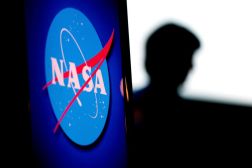NASA spacecraft makes history with Pluto flyby
After a journey of more than nine years and 3 billion miles, NASA’s New Horizons spacecraft came within 7,800 miles of Pluto at 7:49 a.m. Tuesday — the closest any man-made device has come to the icy dwarf planet.
New Horizons’ proximity to Pluto allows unprecedented opportunities for data collection in a frontier previously untouched by science. NASA scientists hope to use the information gathered by the craft — which is speeding through space at more than 30,000 miles per hour — to fuel discoveries about Pluto’s atmosphere as well as its moon Charon.
“Our mission at NASA is to innovate, explore, discover and inspire,” said John Grunsfeld, NASA associate administrator for the Science Mission Directorate and former astronaut, during a televised press briefing. “New Horizons — as an innovative spacecraft, as a mission that’s exploring a new realm, that has already produced new discoveries — will, I believe, produce enormous buzz in the scientific world, and really characterizes the work at NASA.”
NASA engineers were faced with the incredible obstacle of sending the craft through a precise 90-mile-by-60-mile “keyhole” of space on the cusp of Pluto’s atmosphere — a target that had to be plotted from Earth, 3 billion miles away, through a number of complex gravity assists and other maneuvers. According to Glen Fountain, New Horizons project manager, this would be the equivalent of a golfer hitting a ball from New York City to Los Angeles and getting a hole-in-one.
The technical difficulty of the project combined with what Fountain described as Pluto’s “brand” popularity have captured the attention of the public. According to Web traffic analysis, tens of thousands of fans are flocking to NASA’s website every minute.

Screenshot of analytics.usa.gov top 20 from 11:27AM Tuesday.
Due to the spacecraft’s distance from Earth, NASA crews will not receive definite confirmation of the mission’s success until 9:02 p.m., when New Horizons’ “phone home” signal should reach Earth. Traveling at the speed of light, the transmission will take about 4.5 hours to beam through the solar system.
“It sounds like science fiction, but it’s not,” said Alan Stern, New Horizons principal investigator. “The data that we will produce — that we’re already producing — is a gift to mankind for the ages.”
With the confirmation of New Horizons’ success will come a cache of information, including color photographs that will show surface detail at up to 100 meters per pixel, allowing scientists to identify and name geographical formations. The craft is equipped with a suite of seven high-tech instruments, including high-resolution cameras, a space dust collector and an infrared mapping spectrometer. It will spend much of Tuesday in radio silence as all of its onboard systems focus on collecting data.
Cathy Olkin with the Southwest Research Institute spoke to the complexity and risks of the data-collecting mission. New Horizons will perform 150 observations of Pluto during its flyby, rotating in a pre-programmed sequence to orient its instruments toward the target areas. Estimates put the chance of catastrophic debris collision at about one in 10,000 — odds Stern said he “doesn’t lose any sleep over.”
Stern said the mission is more than about gathering data — it’s also about stimulating the next generation’s fascination with space.
“If we can be a small part of making kids excited about STEM careers and degrees in technology through New Horizons, that could be our greatest accomplishment,” he said. “Turning little points of light into planets, we can transform our knowledge. We can write the textbook from scratch.”






